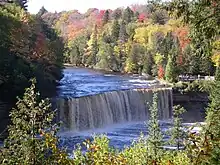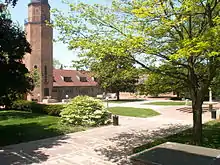Portal:Michigan
The Michigan Portal The flag of Michigan  Location of Michigan within the United States Michigan (/ˈmɪʃɪɡən/ ( Michigan consists of two peninsulas. The Lower Peninsula resembles the shape of a mitten, and comprises a majority of the state's land area. The Upper Peninsula (often called "the U.P.") is separated from the Lower Peninsula by the Straits of Mackinac, a five-mile (8 km) channel that joins Lake Huron to Lake Michigan. The Mackinac Bridge connects the peninsulas. Michigan has the longest freshwater coastline of any political subdivision in the United States, being bordered by four of the five Great Lakes and Lake St. Clair. It also has 64,980 inland lakes and ponds. Michigan has the second-most water area of any state, behind only Alaska. The area was first occupied by a succession of Native American tribes over thousands of years. In the 17th century, French explorers claimed it as part of the New France colony, when it was largely inhabited by indigenous peoples. French and Canadian traders and settlers, Métis, and others migrated to the area, settling largely along the waterways. After France's defeat in the French and Indian War in 1762, the region came under British rule. Britain ceded the territory to the newly independent United States after its defeat in the American Revolutionary War. The area was part of the larger Northwest Territory until 1800, when western Michigan became part of the Indiana Territory. Michigan Territory was formed in 1805, but some of the northern border with Canada was not agreed upon until after the War of 1812. Michigan was admitted into the Union in 1837 as the 26th state, a free one. It soon became an important center of industry and trade in the Great Lakes region, attracting immigrants in the late 19th and early 20th centuries from many European countries. Immigrants from Finland, Macedonia, and the Netherlands were especially numerous. Migration from Appalachia and of Black Southerners as part of the Great Migration increased in the 1930s, with many settling in Metro Detroit. (Full article...)
| ||||||||||||||||||||||||||||||||||||||||||
.jpeg.webp) |
Detroit (/dɪˈtrɔɪt/ dih-TROYT, locally also /ˈdiːtrɔɪt/ DEE-troyt) is the largest city in the U.S. state of Michigan. It is also the largest U.S. city on the United States–Canada border, and the seat of government of Wayne County. The City of Detroit had a population of 639,111 at the 2020 census, making it the 27th-most populous city in the United States. The metropolitan area, known as Metro Detroit, is home to 4.3 million people, making it the second-largest in the Midwest after the Chicago metropolitan area, and the 14th-largest in the United States. Regarded as a major cultural center, Detroit is known for its contributions to music, art, architecture and design, in addition to its historical automotive background. Time named Detroit as one of the fifty World's Greatest Places of 2022 to explore.
Detroit is a major port on the Detroit River, one of the four major straits that connect the Great Lakes system to the Saint Lawrence Seaway. The City of Detroit anchors the third-largest regional economy in the Midwest, behind Chicago and Minneapolis–Saint Paul, and the 16th-largest in the United States. Detroit is best known as the center of the U.S. automobile industry, and the "Big Three" auto manufacturers General Motors, Ford, and Stellantis North America (Chrysler) are all headquartered in Metro Detroit. , the Detroit metropolitan area is the number one exporting region among 310 defined metropolitan areas in the United States. The Detroit Metropolitan Airport is among the most important hub airports in the United States. Detroit and its neighboring Canadian city Windsor are connected through a highway tunnel, railway tunnel, and the Ambassador Bridge, which is the second-busiest international crossing in North America, after San Diego–Tijuana. Both cities will soon be connected by a new bridge currently under construction, the Gordie Howe International Bridge, which will provide a complete freeway-to-freeway link. The new bridge is expected to be open by 2024. (Full article...)Selected biography -
 Goebel in 1922 |
Paul Gordon Goebel (May 28, 1901 – January 26, 1988) was an American football end who played for the University of Michigan Wolverines from 1920 to 1922. He was an All-American in 1921 and was the team's captain in 1922. He played professional football from 1923 to 1926 with the Columbus Tigers, Chicago Bears, and New York Yankees. He was named to the NFL All-Pro team in 1923 and 1924.
After his football career ended, he operated a sporting good store in Grand Rapids. He officiated football games for the Big Ten Conference for 16 years and also served in the U.S. Navy on an aircraft carrier in World War II. He was active in Republican Party politics in Grand Rapids, Michigan, and was one of the organizers of a reform movement to oust the city's political boss, Frank McKay. As an anti-McKay reform candidate, Goebel was three times elected mayor of Grand Rapids in the 1950s. He was later elected to the University of Michigan Board of Regents, where he served from 1962 to 1970. (Full article...)General images
Topics
Categories
Symbols
| Animate insignia | |
| Bird | American Robin (Turdus migratorius) |
| Fish | Brook Trout (Salvelinus fontinalis) |
| Flower | Apple blossom (Malus domestica) |
| Game animal | White-tailed Deer (Odocoileus virginianus) |
| Mammal | Wolverine (Gulo gulo luscus) (unofficial) |
| Reptile | Painted Turtle (Chrysemys picta) |
| Tree | Eastern White Pine (Pinus strobus) |
| Wildflower | Dwarf Lake Iris (Iris lacustris) |
| Inanimate insignia | |
| Fossil | Mastodon (Mammut americanum) |
| Gemstone | Isle Royale greenstone or Chlorastrolite |
| Motto | "Si quaeris peninsulam amoenam circumspice" Latin for "If you seek a pleasant peninsula, look about you" |
| Nicknames |
|
| Soil | Kalkaska Sand |
| Songs | My Michigan |
| Stone | Petoskey stone |
 The Flag of Michigan
The Flag of Michigan The Seal of Michigan
The Seal of Michigan
 State Quarter – Released in 2004
State Quarter – Released in 2004
Lists
- Government
- Governors
- U.S. Representatives
- U.S. Senators
- Mayors of Detroit
- Mayors of Grand Rapids
- Mayors of Lansing
- Mayors of Saginaw
- Mayors of Traverse City
- Counties
- Cities and towns
- People
- Outdoors
- Transportation
- Other
Related pages
 WikiProject Michigan
WikiProject Michigan Michigan Highways portal
Michigan Highways portal
 WikiProject United States
WikiProject United States.svg.png.webp) United States Portal
United States Portal
Wikimedia
The following Wikimedia Foundation sister projects provide more on this subject:
-
 Commons
Commons
Free media repository -
 Wikibooks
Wikibooks
Free textbooks and manuals -
 Wikidata
Wikidata
Free knowledge base -
 Wikinews
Wikinews
Free-content news -
 Wikiquote
Wikiquote
Collection of quotations -
 Wikisource
Wikisource
Free-content library -
 Wikiversity
Wikiversity
Free learning tools -
 Wikivoyage
Wikivoyage
Free travel guide -
 Wiktionary
Wiktionary
Dictionary and thesaurus
Things you can do
 |
Here are some tasks awaiting attention:
|
-
 List of all portalsList of all portals
List of all portalsList of all portals -
 The arts portal
The arts portal -
 Biography portal
Biography portal -
 Current events portal
Current events portal -
 Geography portal
Geography portal -
 History portal
History portal -
 Mathematics portal
Mathematics portal -
 Science portal
Science portal -
 Society portal
Society portal -
 Technology portal
Technology portal -
 Random portalRandom portal
Random portalRandom portal -
 WikiProject PortalsWikiProject Portals
WikiProject PortalsWikiProject Portals
.svg.png.webp)






%252C_Dearborn%252C_Michigan_(14200507431).jpg.webp)
_001.jpg.webp)

_-_exterior.jpg.webp)


















.jpg.webp)
.jpg.webp)
.jpg.webp)
.jpg.webp)










